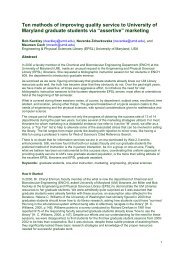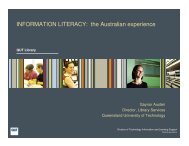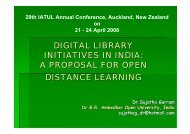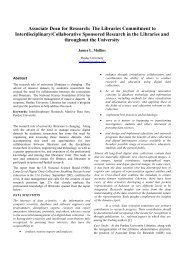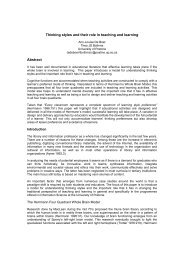Derek Whitehead - IATUL
Derek Whitehead - IATUL
Derek Whitehead - IATUL
Create successful ePaper yourself
Turn your PDF publications into a flip-book with our unique Google optimized e-Paper software.
Contemporary copyright has failed to recognize that innovation and creativity build on the work of<br />
others, and in a knowledge-based or creative economy, innovation is often driven by the “second<br />
mover” principle – new ideas come from existing ideas – and tight controls over intellectual property<br />
may thwart innovation (Flew 2005).<br />
At the same time, the digital revolution has changed the landscape for copyright in a way which would<br />
once have been unimaginable. A wide range of activities has moved from being unregulated to<br />
becoming regulated by law. With a printed book, it is possible to read it, lend it to a friend, quote from<br />
it, put a copy in a library for everyone to use without direct charge. But with a digital publication, most<br />
of those activities involve making a copy, and they are therefore brought into the realm of copyright.<br />
Fitzgerald has pointed out that Web 2.0 social networks which have arisen during the last decade<br />
have created (or reinforced) parallel worlds – one social and sharing, the other commercial (Fitzgerald<br />
2008). It has also given rise to new forms of copyright, and in particular to standardized open licences<br />
– the most common being Creative Commons – by which most commonly the rights of the owner of<br />
copyright are given away, with the exception of two – the right to recognition and the right to make<br />
money from the copyright.<br />
Copyright legislation in individual countries has steadily converged as a result of adherence to the<br />
central role of the World Intellectual Property Organisation (WIPO) and the Berne Convention. This<br />
has facilitated the dominance of copyright by the large corporations which own much of the world’s<br />
valuable intellectual property – publishers, music companies, movie corporations – and has also<br />
tended to bring about increasing uniformity. The incorporation of copyright in international trade<br />
agreements has reinforced this trend.<br />
So let us take this for granted – copyright and innovation are no longer the friends they once were, and<br />
the role of copyright has extended way beyond what is required to support innovation and creativity, so<br />
much so that it often tends to stifle innovation. The move of most of the world’s information into digital<br />
form has reinforced this imbalance.<br />
What can be done to restore the balance? This paper focuses on government policy and practice in<br />
Australia, and the developments which preceded Cutler Report published in September 2008.<br />
Part 2: Australia’s Cutler Report<br />
This paper does not deal with the whole area of copyright and innovation, but takes the Australian<br />
Cutler Report, Venturousaustralia: building strength in innovation (Cutler 2008) and examines some of<br />
the approaches to making copyright better serve innovation, and the potential role of government<br />
policy in better aligning copyright with strategies to foster creativity and innovation.<br />
The Cutler Report has many antecedents, and it is a theme of this paper that governments have been<br />
moving in the direction of open content and open access for some time. Cutler himself (Cutler 2005)<br />
argued strongly several years ago that there was a major failure in public intellectual property policy<br />
which needed to be addressed.<br />
When the current Australian Government came to office in November 2007, it came with plans to<br />
review the approach of government to innovation, the Review of the National Innovation System. It<br />
commissioned Dr Terry Cutler, a consultant working in the cultural and information technology<br />
industries, to review the role of government in fostering innovation. The Cutler Report was released<br />
by the Commonwealth Department of Innovation, Industry, Science and Research (DIISR) in<br />
September 2008.<br />
The report outlines the importance of the information economy and includes a focus on the increasing<br />
importance of intellectual property. It notes in Chapter 7 (information and market design) that the<br />
development of IP is “cumulative” and “new knowledge can only be built on old knowledge”.<br />
The Cutler Report has a specific focus on information generated or held by government, and makes<br />
few recommendations which bear on non-government intellectual property. But the overall approach is<br />
a radical one, as can be seen by the recommendation on the location in government of responsibility<br />
for IP policy.<br />
In broad terms, the report made recommendations in six main areas.<br />
Intellectual Property Policy<br />
“IP policy is economic policy”, Cutler suggests (Cutler, 2008, p.86), and the report links it to<br />
competition policy, or trade practices policy, Copyright needs to move from being a specialist area of<br />
law to “an important front of micro-economic reform.” (p.85) Cutler therefore recommends that this<br />
2



